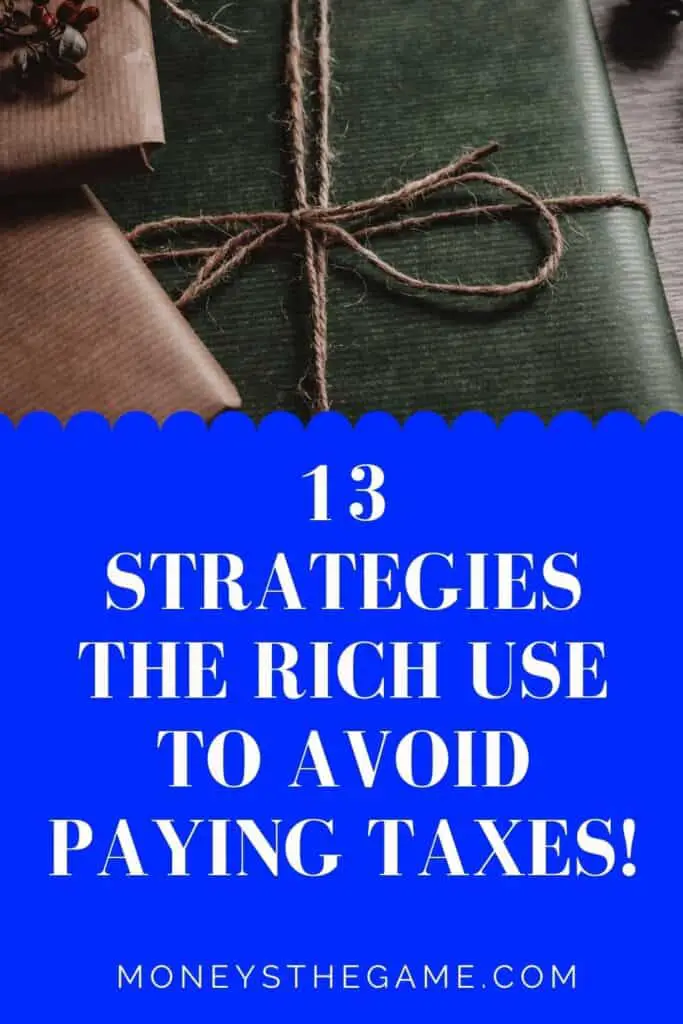This isn’t to say you can’t use some or most of these same advantages in your life but only some may be beneficial depending on your situation.
There are many strategies the rich use to avoid paying taxes, 13 of the most advantageous are:
- Using Corporations And Holding Companies
- Estate Freezing
- Depreciation
- Strategic Loss
- 1031 exchanges
- Deferred Compensation Plans
- Donating
- Not taking a Salary
- Investing In a Business
- Holding Appreciating Assets
- Preferred Stock Options
- Use Leverage
- Capital Gains Advantages
Using Corporations And Holding Companies
By rich, I’m talking about multi-millionaires. These very rich people are extremely likely to be owners of at least one (or more) company or holding company. There are some very strong advantages to using one or both of these together.
Corporations have multiple advantages when it comes to avoiding taxes. If you own a business or corporation you can “write off” or not pay taxes on a lot of expenses. Plus combining a holding company and your active business allows you to take advantage of even more benefits like inter-corporate dividends.
Some of these expenses include:
- Office Supplies
- Rent
- Vehicle Expenses
- Accounting and Legal Fees
- Rent
- Advertising
- Capital Assets
- Entertainment and Food
- Insurance
- Shipping and freight
- Fees and Dues
Even after that long list, there is still more that can be written off by a business. The advantage here is that the business will be able to purchase or pay for these expenses “pre-tax” or “tax-free” by claiming them as a business expense on their tax filing.
For the owner of that business, this is a HUGE advantage. If you were to own this business you can essentially lower your income by thousands of dollars every year in expenses and not pay tax on them. Yet, still, own the assets you have written-off.
The bonus on top of being able to write off these expenses is you can pay for them with pre-tax dollars. Whereas when you are an employee and getting a paycheque every other week your tax liabilities are taken off automatically. THEN you can make these purchases. Therefore, as an employee, you only see the money from your write-offs the next year not throughout that year.
As an employee you don’t get the option to make purchases BEFORE paying tax, you have to make purchases AFTER paying tax as well as not having the advantage of many write-offs.
But, for the business owner to get paid his or her salary, it must come from the profits of the company. This means the company pays taxes on the profits within the corporation, then, the owner is paid a dividend as a shareholder and taxed again as income tax.
Holding Companies
This is where a holding company can come into play for the rich. The holding company is an “entity” on its own. The rich use a holding company “like themselves” in terms of ownership and assets.
The holding company can own the Active Business rather than the “Rich Person”. This separates the owner from his/her business and can allow even further advantages.
The owner may still need to receive some dividends (income) and pay tax but, with a holding company, they can transfer money from the main corporation (Active business) to the holding company without getting taxed the second time (income tax). This process of paying the holding company tax-free is called Inter-corporate dividends and has serious tax savings.
This effectively means the owner doesn’t have to pay income tax on the money sheltered in the holding company and only pays corporate tax. (With the write-offs from business expenses) This will allow the owner to save roughly 20-30% in “personal tax” that would normally be taken from their tax filing.
To take it one step further, the owner of the holding company can then purchase Assets such as Stocks, Bonds, Real Estate or, other private corporations with “half tax-free” money effectively adding 20-30% more investment power.
Combined that with compound interest and you have a recipe for success!

Estate Freezing
Particularly in Canada Estate Freezing can save people A LOT in taxes when used appropriately.
Estate Freezing is “Freezing” or “stopping” the appreciation of Assets held in an estate so that the Assets can be transferred to the beneficiary upon death without having to pay as much in Capital gains tax.
Upon death, people are required to pay taxes on their estate. If you have assets that have appreciated over many years upon your death, your estate will have to pay capital gains tax on the appreciated value. This tax is paid on 50% of the estate value and can be upwards of 20-30% of the overall value.
For example, If Jim purchased a home in 1980 for $35,000. Upon his death, in the year 2000 let’s imagine his home was worth $200,000. Over the 20 years, Jim’s home would have appreciated by $165,000.
To transfer the value of that home to Jim’s beneficiaries, Jim’s Estate would need to pay Capital Gains tax on the $165,000.
Because Capital Gains are added to your income tax at 50%, $82,500 would be added to the taxable income of his estate for that year. (Appreciated value $165,000/2= $82,500)
If Jim’s income for that year was $50,000 and now had $82,500 added to it his Estate would be taxed on $132,500. Meaning, Jim’s Estate would have to pay about $42,000 in taxes because of appreciation and Capital Gains!
This is where Estate Freezing can be used to lower the tax burden upon death. If in 1990, Jim had initiated an Estate Freeze and his home was valued at $65,000, he would be able to pass the appreciated value upon his death tax-free to his children.
By Estate Freezing Jim effectively lowered his taxable income for the year of his death by $100,000 saving his Estate a lot in Capital Gains tax.
Depreciation
The rich can avoid paying taxes on income by using depreciation to offset “erosion” in Asset value over time or “the life expectancy” of the Asset. If an investor purchases a vehicle, that vehicle has a “life expectancy” or an amount of time before the Asset is no longer useful.
This constant erosion of value is called depreciation and can be used to offset income and lower tax burdens. Multiple Assets can be depreciated by accountants including machinery, equipment, buildings, vehicles, and furniture as well as intangible assets such as patents, copyrights or, software.
Using Depreciation is very effective in lowering your taxable income and can bring your taxable income to $0 but not negative. One of the most common businesses that rely on depreciation is Real Estate.
To fully depreciate the value of a residential property takes 27.5 years. So, if you purchased a residential property for $200,000 and rented it out. If every month, you gained a net profit (the bottom line) of $500 your income would be $6,000 a year. ($500 X 12 months)
The first year you would only be able to depreciate a portion of the home’s value but it still helps alleviate your tax burden.
With 27.5 years of depreciation available, in the first year, you would be able to depreciate $2,727.27 from your income of $6,000. This means you would only have to pay taxes on the remaining income. $6,000- $2,727.27 =$3,272.73 of taxable income the first year.
However, in the second year, you would be able to depreciate on the full value allowing you to depreciate a total of $7,272.72 which is more than the total income of the property! This means you will be making tax free money just from depreciation for over 30 years!
Strategic Loss or Tax-loss Harvesting
Strategic Loss or Tax-loss Harvesting is purposely selling an investment that is losing money to offset capital gains tax burdens made from another investment.
If an investor sells a security that is in a losing position, it will allow a credit to go against any capital gains made from selling another security. Then the losing Asset is replaced with a similar position effectively giving the portfolio a tax credit while maintaining Asset allocation.
If you have one security (“A”) that has increased in value and you sell it for a profit. Tax Loss Harvesting would be, selling security “B” at a loss to offset the Capital gains tax liability.
After creating the tax credit from the loss, you would purchase a similar security as “B” to keep the same portfolio allocation.
This can eliminate or greatly lower any tax liability accrued from Capital gains.
1031 Exchanges
Real Estate has been a long time investment platform for many investors. Even though you can depreciate the value of the property against income there can still be Capital gains tax accrued from the sale of a property.
Thankfully, a 1031 exchange can be used to avoid paying taxes on the sale of a property so long as certain criteria are met.
An investor can use a 1031 exchange to sell a property and defer paying taxes on the Capital Gains as long as the investor purchases another “like-kind property”.
This allows investors to keep all their profits made from the appreciation of an investment property and then purchase another like-kind property without paying taxes first. Effectively swapping one investment for another and deferring the taxes until later.
Another benefit that the rich use to avoid taxes under a 1031 exchange is that there is no limit to how many times or how often you can use a 1031 exchange to “swap” properties and defer paying Capital gains tax.
Multiple things are affecting a 1031 exchange which is why an accountant is always needed but knowing you can use this to defer taxes is especially useful.

Deferred Compensation Plans
A Deferred Compensation Plan is when a company withholds a portion of an employee’s wages until a specified date. There are many plans available including; pensions, retirement plans, and employee stock options.
Normally the wages are withheld for retirement and then paid out on the specific date specified.
The two types of Deferred Compensation Plans are a qualified and non-qualified Deferred Compensation Plan.
A Qualified Deferred Compensation Plan is one that is in compliance with the Employee Retirement Income Security Act (ERISA) and is available to everyone non-discriminatory such as a 401(k).
A Non-Qualified Deferred Compensation Plan is a written agreement between employer and employee that allows the company to withhold a portion of the employee’s income, invest it, and pay it out at a later date. This can also allow for specific parties such as executives to defer compensation with no-limit to contributions and lower taxable income for that year.
Being that Deferred Compensation Plans lower taxable income it can be an effective way to avoid paying taxes until a further date such as retirement.
Get the BEST Savings Account available From CIT today!
Donating
Making donations is a great way to lower taxable income and benefits the community at the same time.
When used strategically, donations can be used to lower taxable income into another tax bracket. This can change the amount of tax needing to be paid by a large percentage.
In Ontario, a small business can take advantage of the small business tax deduction which allows small businesses to reduce taxes by 19% effective Jan 2019 tax up to $500,000 in income. But if the small business was to make $510,000 they would not qualify and be taxed at a MUCH higher rate.
In this case, the small business could donate the difference and give them a tax credit lowering their income back down under the $500,000 mark to qualify.
Also, a business owner may choose to donate from their holding company rather than an active business. This can be advantageous because the investment income in the holding company is generally taxed at a higher rate than income from an active business.
Not Taking A Salary
One of the easiest ways for a business owner to avoid paying taxes is to just leave the money in their company. Simple and effective!
The portion of profits that is still held within the company is called Retained Earnings. A company does not have to pay income tax on retained earnings because they are the after-tax profit of the company.
The company will still have to pay corporate tax beforehand but the profit after corporate tax is retained and can be re-invested into the company. A business owner can use this to their advantage by making purchases within the company.
These purchases still need to be company based but if the business uses the retained earnings to purchase a new truck rather than paying the owner, paying income tax, and then buying a truck.
There can be a tax savings of about 25-35%.
Some very wealthy people take extremely low salaries and retain as much inside their corporations as possible because they can take advantage of the corporate buying power without having to pay income tax from a higher salary.
Investing In A Business

For many entrepreneurs, the dream of owning a business is a scary adventure. Fortunately, there are at least some parts of the adventure that can help your tax burden.
If you are an aspiring entrepreneur or one with some free cash floating around, you can start a new business and have a nice write-off come tax time.
If you start a business, the Canada Revenue Agency (CRA) allows you to deduct your start-up costs as allowable business expenses. However, the expenses must be incurred after the day your business commences to qualify for this deduction.
This is one of the many ways that the rich use to avoid taxes and in starting a business they are creating another income stream for years to come!
Other rules apply for when and how much you can write-off but, investing in your business is a great way to lower your tax burden.
The Rich also Invest in businesses that have already been started. Starting your own business or buying one requires you to have some knowledge of financial statements, after all, financial statements are all about how the business is making money!
To get a foot above everyone around you Start Right Now with the Beginner’s Guide to Analyzing Financial Statements!
Holding Appreciating Assets
This is a simple way to not pay any taxes, don’t sell the Asset!
As Warren Buffet said, “Our favourite holding period is forever.”

Why sell an Asset that’s making money? There are a lot of Assets that appreciate and can be held forever. Real estate appreciates and can be a huge income stream for YEARS!
Stocks and other securities can be great investments that provide income and appreciated value over a long time. After all, that is how Warren Buffett made his billions!
So when you start investing and don’t feel like paying taxes, take the boring route and don’t sell the Asset! Investing is about long term gains, by constantly buying and selling you will just end up paying taxes over and over on your investments.
It is worth the extra time to go over any investment and buy to hold not buy to flip.
Warren Buffett started buying shares in Coke in 1988 and still owns them today. He has amassed such a large investment portfolio in different companies by buying and holding them forever! He doesn’t pay taxes on the investment because he hasn’t realized the rains from the appreciation.
Preferred Stock Options
Preferred Stock Options are a type of “stock” or ownership in a public company that has a higher priority over common stock. The owner of the preferred stock has more claims to distributions than common stock. That is, they have more claims over the dividends a company pays to its shareholders.
The preferred stock can be issued by a corporation as an option to executives as compensation which can be used to lower taxable income because it is an appreciating asset and has first dibs on dividends paid.
Preferred stock dividends are also normally taxed more favorably than standard income which can help lower taxes in the long run as well as having the chance to purchase the stock for a lower price.
Preferred stock can be offered as compensation where the purchase price is significantly lower than the common stock price. By offering this option within the corporation it can allow the parties to increase income without paying taxes until the stock is sold.
For example, company XYZ has a common stock price of $100 per share. XYZ then gives a preferred stock option to its executives as compensation where they can purchase preferred stock for $50 a share but can’t convert it to common shares for 5 years.
This type of compensation would allow the executives to purchase preferred stock in the company at 50% of the share price essentially doubling their compensation as well as having priority when dividends are paid.
Now, only when the securities are paid will they have to pay taxes on the appreciated price on the stock option.
Using Leverage
Leverage is a common way to get access to money tax-free for investing purposes. The problem with leverage is it is debt used to purchase assets that can potentially lose money.
But, you can increase your available investment power by using debt to make money. The most common way of using debt (leverage) to make money is in Real Estate.
An investor borrows money (leverages the bank’s money) to buy an investment property that will make them money over time. Typically, they will need a minimum of 20% down to do this but it also means that an investor has to put a down-payment of $200,000 to purchase $1,000,000 property.
Then, the investor has effectively gotten $800,000 TAX-FREE to invest with.

By doing this rather than just buying a $200,000 property the investor can increase their return on investment by as much as 4-7X depending on the cash flow.
It’s not all free from risk though. Borrowing money to invest in a potentially dangerous situation and has lost a lot of people’s fortunes. Real Estate is seen as one of the safer options when borrowing money to invest but it doesn’t mean there are no risks.
And, because borrowing money to invest increases your returns, losing money when leveraged can increase your losses.
Capital Gains Advantage
Capital Gains has been talked about multiple times, but there is a very distinct advantage in making money using it.
You only get taxed on 50% of the capital Gains accrued!
That means if you buy an investment for $100,000 and sell it 5 years later for $1,000,000 you will have made Capital gains of $900,000. When taxes come due, you claim it as Capital Gains and only have to pay taxes on $450,000. ($900,000/2)
If you’re paying 30% tax, you will save A LOT on taxes by claiming Capital Gains on that investment!
Combined that with other strategies and you can lower your taxes even further!
Conclusion
There are so many ways that the rich avoid taxes, it pays to have great lawyers and skilled accountants! The rich avoid paying taxes because they use the tax laws in their favor to get the best results possible!
Always check with your accountant or tax professional, you never know, you may have a lot more you can take advantage of too!

Say, you got a nice blog post. Really looking forward to read more. Keep writing. Emmalyn Alberik Noam
Thank you! Don’t worry, I will be writing more. Thanks for commenting, I’m happy you found the post insightful.